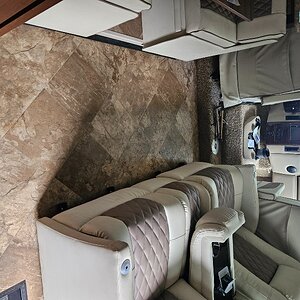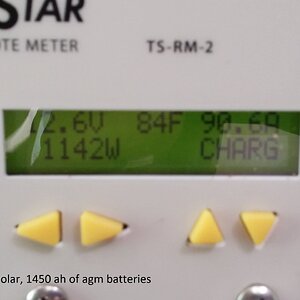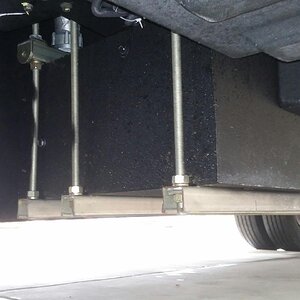marc2912
RVF Supporter
- Joined
- Aug 12, 2021
- Messages
- 296
- Location
- New York
- RV Year
- 2015
- RV Make
- Newmar
- RV Model
- Dutch Star 4312
- RV Length
- 43'
- Chassis
- Freightliner
- Engine
- Cummins 450HP
- TOW/TOAD
- '22 Wrangler JLU w/ Air Force One and Blue Ox
- Fulltimer
- No
So just a warning that this is probably going to be a wall of text. You might have seen my name here and there, I purchased a 2015 Dutch Star for me and my family to travel a few months back. I went from nothing, to deciding to make a drastic change in the way we live our lives etc. This purchase is also tied around an up and coming move and my wife being able to stop working for a while and me being able to work fully remote.
After reading a lot, looking at a lot of videos, talking to a lot of people, and searching for a class A that works for us I finally pulled the trigger at the start of the year. Besides the Diesel prices, lol (you can only laugh about it because the alternate is crying) and the fact that prices are crashing for used RVs because of those Diesel prices I don’t have any regrets.
I drove back the beast from Houston to NY and we even took our first trip in it for Easter weekend. I have no room where I live to store it but my brother in law has a large driveway about an hour north of us and we’ve been parking it there. I think I’ve figured most of the plumbing/sewer system, we have a macerating sewer out which is nice, though I honestly don’t understand the need or gain from it. Why does the waste need to be shredded prior to getting pushed down an RV park sewer line…
Anyways, the one system I’m really still not 100% with is the electric system. I understand the house battery setup, I understand the chassis battery setup, I understand the inverter, I understand that the chassis battery are two large starting battery for cranking over the diesel (and it seems the generator?). The chassis batteries seem to be 8x 6V marine/deep cycle battery with two banks of 4 in parallel and the two banks in series two give me 12V. From there it goes to the inverter which can bring it up to 110V and also charge the batteries as needed.
Now silly me I figured if all power was off I could leave the RV parked for shorter periods of times. I.E. a few weeks. When I returned from Houston the bus sat a week at a time since between me going to it to work on it. While working on it I would start the generator for a few hours (4 or so) and return the week after. After a few weeks we went on our Easter trip. I returned and parked the RV and didn’t get to come back to it for 2 weeks. Generator was a hard start and I hit the power boost and it turned over. I ran it for 4 hours while working on things. I didn’t get to return for another 2 weeks. This time everything was dead. It looks like it’s possibly going to be a very expensive lesson.
I checked chassis batteries individually and both were around 5V, the house batteries were reading at 5.6V at the inverter instead of 12V. I tried hooking to shore power via 15amp cord, but the inverter refused to charge the batteries and returned a fault and dead battery message. I put one of the chassis batteries on a battery tender, (I went out and purchased a decent one) and it reported the battery as bad. Even after 4 hours on the tender the battery refused to take a charge. Both chassis batteries needed to be replaced. This gave me power back to start the engine / generator. Once I started the generator the inverter started charging the house batteries. After charging for about 2 hours I had to leave so I killed the generator, and watched the battery voltage drop between 9-10 volts, my hope is the house batteries being deep cycle will recover better from such a low voltage than the chassis battery. I reconnected the shore power and set the controller on the magnum inverter to max pull 10amp from the shore power. It resumed charging which was a good sign.
Before leaving I went back to the chassis battery bay where there is a large disconnect switch and i turned it off, it seems to kill power which prevents engine / generator function. This doesn’t seem to affect the inverter or house battery charging. I also did trip pretty much everything from the main breaker panel.
Now $600 on new batteries and a battery tender here’s what I learned: my RV can’t sit for any extended period of time disconnected from power. My assumption is that there are decent phantom battery drains which is what led to me finding the RV in the state it was in. I’m assuming that as I have it now it should be sustainable from a battery management standpoint but looking for advice/viewpoints.
Some questions thought…
I did warn you, wall of text, and for that I apologize. If you read this far and have any advise please do share.
After reading a lot, looking at a lot of videos, talking to a lot of people, and searching for a class A that works for us I finally pulled the trigger at the start of the year. Besides the Diesel prices, lol (you can only laugh about it because the alternate is crying) and the fact that prices are crashing for used RVs because of those Diesel prices I don’t have any regrets.
I drove back the beast from Houston to NY and we even took our first trip in it for Easter weekend. I have no room where I live to store it but my brother in law has a large driveway about an hour north of us and we’ve been parking it there. I think I’ve figured most of the plumbing/sewer system, we have a macerating sewer out which is nice, though I honestly don’t understand the need or gain from it. Why does the waste need to be shredded prior to getting pushed down an RV park sewer line…
Anyways, the one system I’m really still not 100% with is the electric system. I understand the house battery setup, I understand the chassis battery setup, I understand the inverter, I understand that the chassis battery are two large starting battery for cranking over the diesel (and it seems the generator?). The chassis batteries seem to be 8x 6V marine/deep cycle battery with two banks of 4 in parallel and the two banks in series two give me 12V. From there it goes to the inverter which can bring it up to 110V and also charge the batteries as needed.
Now silly me I figured if all power was off I could leave the RV parked for shorter periods of times. I.E. a few weeks. When I returned from Houston the bus sat a week at a time since between me going to it to work on it. While working on it I would start the generator for a few hours (4 or so) and return the week after. After a few weeks we went on our Easter trip. I returned and parked the RV and didn’t get to come back to it for 2 weeks. Generator was a hard start and I hit the power boost and it turned over. I ran it for 4 hours while working on things. I didn’t get to return for another 2 weeks. This time everything was dead. It looks like it’s possibly going to be a very expensive lesson.
I checked chassis batteries individually and both were around 5V, the house batteries were reading at 5.6V at the inverter instead of 12V. I tried hooking to shore power via 15amp cord, but the inverter refused to charge the batteries and returned a fault and dead battery message. I put one of the chassis batteries on a battery tender, (I went out and purchased a decent one) and it reported the battery as bad. Even after 4 hours on the tender the battery refused to take a charge. Both chassis batteries needed to be replaced. This gave me power back to start the engine / generator. Once I started the generator the inverter started charging the house batteries. After charging for about 2 hours I had to leave so I killed the generator, and watched the battery voltage drop between 9-10 volts, my hope is the house batteries being deep cycle will recover better from such a low voltage than the chassis battery. I reconnected the shore power and set the controller on the magnum inverter to max pull 10amp from the shore power. It resumed charging which was a good sign.
Before leaving I went back to the chassis battery bay where there is a large disconnect switch and i turned it off, it seems to kill power which prevents engine / generator function. This doesn’t seem to affect the inverter or house battery charging. I also did trip pretty much everything from the main breaker panel.
Now $600 on new batteries and a battery tender here’s what I learned: my RV can’t sit for any extended period of time disconnected from power. My assumption is that there are decent phantom battery drains which is what led to me finding the RV in the state it was in. I’m assuming that as I have it now it should be sustainable from a battery management standpoint but looking for advice/viewpoints.
Some questions thought…
- Why were my chassis batteries dead, I would have assumed that the chassis batteries were on an independent system and that they wouldn’t have been drained
- Also associated to the chassis battery is wether or not the inverter would also charge those or are they only recharged from the actual Diesel engine running?
- Is the shutoff switch i killed in the Chassis battery bay what I think it is? By that I mean have I isolated those batteries preventing possible discharge?
- What is the main power shutoff switch in the RV on the main control panel? (It has a post it which says do not use without assistance, I still need to google that one but any assistance is appreciated).
- I think my RV might even have a generator auto start setup. Is that configured through the Magnum controller? Also does that do what I think, and by that I mean would that automatically start and stop the generator to recharge the house batteries when they drop below a certain voltage? Is that safe to let run unsupervised
- Considering getting a 600 watt solar array to prevent any of this from repeating itself since it seems the RV was pre-wired for Solar by Newmar, thoughts on that approach.
I did warn you, wall of text, and for that I apologize. If you read this far and have any advise please do share.














